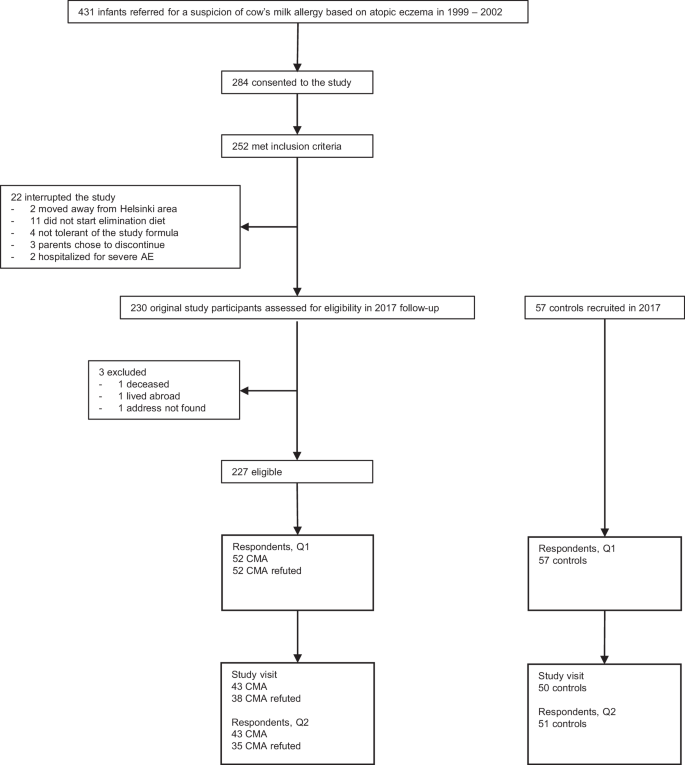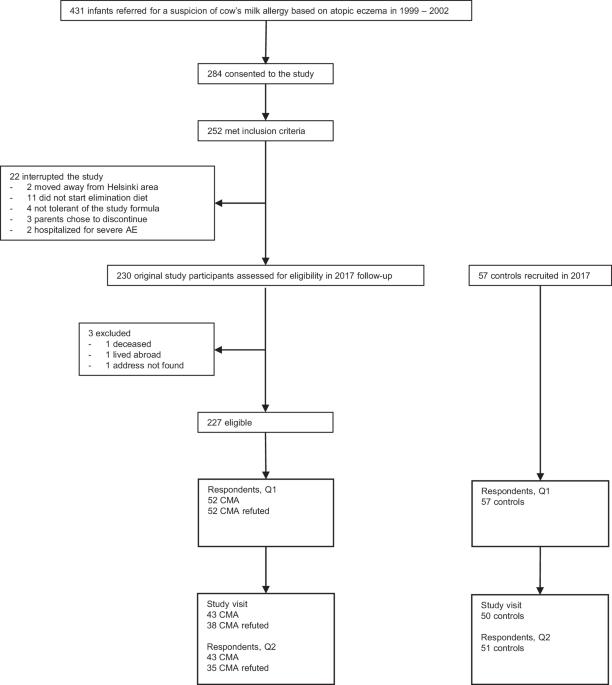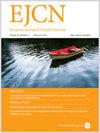Dairy consumption and vitamin D concentration in adolescents with challenge-confirmed cow’s milk allergy during infancy
IF 3.6
3区 医学
Q2 NUTRITION & DIETETICS
引用次数: 0
Abstract
Milk is an important source of dietary calcium and, if fortified, vitamin D. Cow’s milk allergy (CMA) is treated with a milk elimination diet. Although most children become tolerant by age 3 years, some continue dairy avoidance. It remains unclear whether adolescents with a history of CMA adopt similar milk consumption as their peers. We assessed dairy consumption and concentration of serum 25-hydroxyvitamin D (25(OH)D) in adolescents with either confirmed CMA or a negative CMA challenge in infancy (CMA-refuted group) and age-matched controls. This study is based on a previously reported randomized controlled trial from 1999 to 2002 on the treatment effect of probiotics on atopic eczema in participants aged <12 months (n = 230) with data on CMA status. We followed up these participants, aged 15–18 years, in 2017 (n = 104). A 20-item food frequency questionnaire assessed dairy consumption. An automated immunoassay measured 25(OH)D concentration. Median dairy product consumption did not differ between adolescents with CMA (449 g/d, n = 40), the CMA-refuted group (566 g/d, n = 36), and controls (235 g/d, n = 51) (P = 0.117). Median 25(OH)D concentrations were 76.0, 79.3, and 80.8 nmol/l, respectively (P = 0.844). Among participants, 93% were vitamin D sufficient (25(OH)D ≥ 50 nmol/l), with no differences between groups (P = 0.914). Among adolescents with a history of CMA during infancy, our study found no reintroduction failure of milk and no difference in vitamin D insufficiency rate compared with peers. Current management of CMA seems to adequately minimize later nutritional disadvantages associated with a cow’s milk elimination diet.


婴儿期经质疑证实对牛奶过敏的青少年的奶制品摄入量和维生素 D 含量
背景/目的牛奶是膳食钙的重要来源,如果经过强化,还能补充维生素 D。虽然大多数儿童在 3 岁时就能耐受牛奶,但仍有一些儿童继续回避牛奶。有 CMA 病史的青少年是否与他们的同龄人一样饮用牛奶,目前仍不清楚。我们评估了确诊为 CMA 或婴儿期 CMA 阴性的青少年(CMA 阴性组)以及年龄匹配的对照组的牛奶摄入量和血清 25- 羟维生素 D (25(OH)D) 的浓度。我们在 2017 年对这些 15-18 岁的参与者进行了随访(n = 104)。一份包含 20 个项目的食物频率问卷评估了乳制品的消费情况。结果患有 CMA 的青少年(449 克/天,n = 40)、CMA 筛选组(566 克/天,n = 36)和对照组(235 克/天,n = 51)之间的乳制品中位消耗量没有差异(P = 0.117)。25(OH)D 浓度中值分别为 76.0、79.3 和 80.8 nmol/l(P = 0.844)。结论我们的研究发现,在婴儿期曾患 CMA 的青少年中,没有人再引入牛奶失败,维生素 D 不足率与同龄人相比也没有差异。目前对 CMA 的处理方法似乎能充分减少日后与杜绝牛奶饮食相关的营养弊端。
本文章由计算机程序翻译,如有差异,请以英文原文为准。
求助全文
约1分钟内获得全文
求助全文
来源期刊
CiteScore
10.60
自引率
2.10%
发文量
189
审稿时长
3-6 weeks
期刊介绍:
The European Journal of Clinical Nutrition (EJCN) is an international, peer-reviewed journal covering all aspects of human and clinical nutrition. The journal welcomes original research, reviews, case reports and brief communications based on clinical, metabolic and epidemiological studies that describe methodologies, mechanisms, associations and benefits of nutritional interventions for clinical disease and health promotion.
Topics of interest include but are not limited to:
Nutrition and Health (including climate and ecological aspects)
Metabolism & Metabolomics
Genomics and personalized strategies in nutrition
Nutrition during the early life cycle
Health issues and nutrition in the elderly
Phenotyping in clinical nutrition
Nutrition in acute and chronic diseases
The double burden of ''malnutrition'': Under-nutrition and Obesity
Prevention of Non Communicable Diseases (NCD)

 求助内容:
求助内容: 应助结果提醒方式:
应助结果提醒方式:


